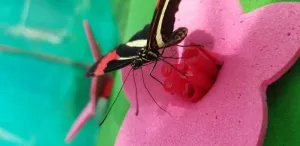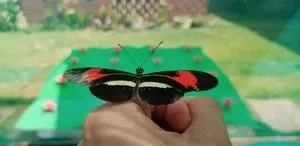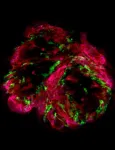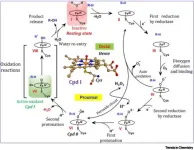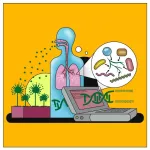(Press-News.org) Heliconius butterflies are capable of spatial learning, scientists have discovered.
The results provide the first experimental evidence of spatial learning in any butterfly or moth species.
The findings, published today in Current Biology, also suggest Heliconius butterflies may be able to learn spatial information at large scales, consistent with the apparent importance of long-range spatial learning for traplining, which involves foraging within a home range of a few hundred square metres.
Spatial learning is known in insects, but much of the research has focused on ant and bee species which live socially in a communal nest. This study provides the first direct evidence of spatial learning in butterflies or moths, and suggests that complex learning skills, such as the use of spatial information, may be more common in insects than previously thought.
Dr Stephen Montgomery of the University of Bristol’s School of Biological Sciences, a senior author, explained: “Heliconius butterflies have evolved a novel foraging behaviour amongst butterflies – feeding on pollen.
“Wild Heliconius appear to learn the location of reliable pollen sources and establish long-term ‘traplines’.
“Traplines are learnt foraging routes along which food sources are repeatedly returned to over consecutive days, an efficient foraging strategy similar to the behaviour of some orchid bees and bumblebees. However, the spatial learning abilities of Heliconius, or indeed any butterfly, had not yet been experimentally tested.”
The team conducted spatial learning experiments in Heliconius butterflies over three spatial scales representing ecologically-relevant behaviours.
First, they tested the ability of Heliconius to learn the location of a food reward in a 1 m2 grid of 16 artificial flowers, representing foraging within a single resource patch.
Second, they increased the spatial scale and tested whether Heliconius could learn to associate food with either the left or right side of a 3 m2 two-armed maze, representing multiple plants at a single locality.
They then increased the distances again and, using large outdoor cages at the Metatron in southern France, tested if Heliconius could learn the location of food in a 60 m wide T-maze, representing foraging between localities and approaching the scales over which wild Heliconius forage.
Now the team plans to test whether Heliconius are more proficient spatial learners than closely related species that don’t feed on pollen. This would help to reveal how the evolution of enhanced cognitive abilities can be shaped by an animal’s ecology. Additionally, the research group aims to uncover the mechanisms by which Heliconius navigate, which are unknown. Visual cues, such as panoramic views, are believed to be important for Heliconius, but they may also rely on other cues such as a sun or geomagnetic compass.
“It’s been almost a century since the publication of the first anecdotal story on the spatial capabilities of these butterflies. Now we are able to provide actual evidence on their fascinating spatial learning. And this is just the beginning,” Dr Priscila Moura, co-lead author based at Universidade Federal do Rio Grande do Norte said.
“We are excited to present the first direct evidence of spatial learning in a butterfly. Consistent with their wild foraging behaviour, our findings also suggest more effective spatial learning across larger distances,” said Dr Fletcher Young, co-lead author at University of Bristol.
“We are thrilled to find out that these amazing insects can memorise the spatial location of food sources. We are just beginning to get a glimpse of the kinds of information they gather about their surroundings,” said Prof Marcio Cardoso, co-supervisor, of Universidade Federal do Rio de Janeiro.
Dr Montgomery concluded: “It’s fascinating to learn about the complex behaviours that even familiar animals like butterflies express as part of their natural ecologies. These species are extracting and processing diverse information from their environment and using them to perform complex tasks – all with brains a couple of millimetres wide.”
Notes to editors
Paper:
‘Rapid expansion and visual specialisation of learning and memory centers in the brains of Heliconiini butterflies’ by Antoine Couto, Stephen Montgomery et al in Current Biology.
Images
Fig 1
Butterfly maze
https://fluff.bris.ac.uk/fluff/u2/hu21584/9JwcdOw4gQ8rQ9a7nvXuJwDto/
Credit: Dr Stephen Montgomery
Fig 2
Heliconius butterfly locating food
https://fluff.bris.ac.uk/fluff/u3/hu21584/eRoBU9eoLmXSW4yogf8fkQDtu/
Credit: Priscila Moura
Fig 3
Heliconius butterfly
https://fluff.bris.ac.uk/fluff/u3/hu21584/qHfFCJDfCfGONn_uqgcveQDtg/
Credit: Priscila Moura
Fig 4
Heliconius butterfly
https://fluff.bris.ac.uk/fluff/u2/hu21584/7ZN0p4bBHKFrzLhxLWXLdADtz/
Credit: Priscila Moura
END
Butterflies can remember where things are over sizeable spaces, new study finds
Heliconius butterflies are capable of spatial learning, scientists have discovered
2023-08-07
ELSE PRESS RELEASES FROM THIS DATE:
AI model can help determine where a patient’s cancer arose
2023-08-07
CAMBRIDGE, MA -- For a small percentage of cancer patients, doctors are unable to determine where their cancer originated. This makes it much more difficult to choose a treatment for those patients, because many cancer drugs are typically developed for specific cancer types.
A new approach developed by researchers at MIT and Dana-Farber Cancer Institute may make it easier to identify the sites of origin for those enigmatic cancers. Using machine learning, the researchers created a computational model that ...
Using social media to raise awareness of women’s resources
2023-08-07
CAMBRIDGE, MA The Covid-19 pandemic created a global increase in domestic violence against women. Now, an MIT-led experiment designed with that fact in mind shows that some forms of social media can increase awareness among women about where to find resources and support for addressing domestic violence.
In the randomized experiment, set in Egypt, women recruited via Facebook were sent videos via social media as well as reminders to watch television programming from a well-known Egyptian human rights lawyer focused on gender norms and violence. The study found that receiving the videos or reminders increased consumption of media content about the issue, increased knowledge ...
Dana-Farber AI-model predicts primary source of cancer using gene sequencing data
2023-08-07
BOSTON – Researchers at Dana-Farber Cancer Institute have created an AI-based tool that uses tumor gene sequencing data to predict the primary source of a patient’s cancer. The study, published in in Nature Medicine, suggests that this predictive tool, called OncoNPC, could help guide treatment of cancer and improve outcomes in difficult to diagnose cases.
The primary source of cancer is traditionally diagnosed by a standardized diagnostic work-up, including radiology and pathology assessments based on slides of cells taken from a tumor biopsy. In 3-5% of cancer ...
Game-changing potential for drug testing and cardiovascular disease treatments - Tiny Heart Model Carries Massive Implications
2023-08-07
A remarkable breakthrough, a collaborative team of researchers, led by Professor Yaakov Nahmias from The Hebrew University of Jerusalem, Technion-Israel Institute of Technology, and Tissue Dynamics Ltd., has unveiled a miniature human heart model that could potentially transform drug testing and cardiovascular research. This study, published in Nature Biomedical Engineering, introduces a self-paced multi-chambered human heart model, no larger than a grain of rice, which promises to revolutionize the way we study the heart and its functions.
Cardiovascular ...
Fanning the flames
2023-08-07
As Canadian wildfire smoke continues to impact large swaths of the United States, resulting in poor air quality and negative health outcomes for millions of Americans, more people than ever are feeling the effects of longer fire seasons and a changing climate. Now, researchers at Washington University in St. Louis have discovered that wildfires may have even bigger climate impacts than previously thought.
In a new study published Aug. 7 in Nature Geoscience, researchers led by Rajan Chakrabarty, the Harold D. Jolley Career Development Associate Professor in the ...
Effective medications for opioid use disorder rarely used
2023-08-07
Most individuals diagnosed with opioid use disorder are not on recommended medications and even fewer remain in care, according to a research letter published today in JAMA Internal Medicine by lead author Ashley Leech, PhD, assistant professor in the Department of Health Policy at Vanderbilt University Medical Center (VUMC).
In 2021, there were more than 100,000 overdose deaths in the United States, with the highest rates among those ages 25-54.
Just 22% of the 40,000 individuals with opioid use disorder studied by VUMC researchers continuously used ...
Discovery in nanomachines within living organisms - cytochromes P450 (CYP450s) unleashed as living soft robots
2023-08-07
[Jerusalem, Israel] Study reveals an important discovery in the realm of nanomachines within living systems. Prof. Sason Shaik from the Hebrew University of Jerusalem and Dr. Kshatresh Dutta Dubey from Shiv Nadar University, conducted molecular-dynamics simulations of Cytochromes P450 (CYP450s) enzymes, revealing that these enzymes exhibit unique soft-robotic properties.
Cytochromes P450 (CYP450s) are enzymes found in living organisms and play a crucial role in various biological processes, particularly in the metabolism of drugs and xenobiotics. The researchers' simulations demonstrated that CYP450s possess a fourth dimension - the ability to sense and respond to ...
Scientists crack the code of what causes diamonds to erupt
2023-08-07
An international team of scientists led by the University of Southampton has discovered that the breakup of tectonic plates is the main driving force behind the generation and eruption of diamond-rich magmas from deep inside the Earth.
Their findings could shape the future of the diamond exploration industry, informing where diamonds are most likely to be found.
Diamonds, which form under great pressures at depth, are hundreds of millions, or even billions, of years old. They are typically found in a type of volcanic rock known as kimberlite. Kimberlites are found in the oldest, thickest, ...
A fungus gets comfortable
2023-08-07
Aspergillus fumigatus strains that infect humans have a significantly altered metabolism compared to other strains in the environment. At the same time, infection with the fungus leads to an apparent change in the human lung microbiome. Researchers at the Leibniz Institute for Natural Product Research and Infection Biology (Leibniz-HKI) in Jena, Germany, came to this conclusion after using machine learning models to analyze genome data from about 250 fungal strains and lung microbiome data from 40 patients.
The fungus Aspergillus fumigatus is widely distributed in the environment, where it performs important ecological functions. ...
CEHD researchers receive funding for project on quantum teaching & learning in elementary classrooms
2023-08-07
Nancy Holincheck, Assistant Professor, Advanced Studies in Teaching and Learning, School of Education; Jessica Rosenberg, Associate Professor, Physics and Astronomy; Stephanie Dodman, Associate Professor, School of Education; and Benjamin Dreyfus, Associate Professor, Physics and Astronomy, received funding from the National Science Foundation for the project: "EAGER: Quantum is Elementary: Quantum Teaching & Learning in Elementary Classrooms."
The researchers will study learning associated with elementary teachers' engagement in professional learning and elementary students' learning related to quantum science, quantum thinking, and careers. The ...
LAST 30 PRESS RELEASES:
Making lighter work of calculating fluid and heat flow
Normalizing blood sugar can halve heart attack risk
Lowering blood sugar cuts heart attack risk in people with prediabetes
Study links genetic variants to risk of blinding eye disease in premature infants
Non-opioid ‘pain sponge’ therapy halts cartilage degeneration and relieves chronic pain
AI can pick up cultural values by mimicking how kids learn
China’s ecological redlines offer fast track to 30 x 30 global conservation goal
Invisible indoor threats: emerging household contaminants and their growing risks to human health
Adding antibody treatment to chemo boosts outcomes for children with rare cancer
Germline pathogenic variants among women without a history of breast cancer
Tanning beds triple melanoma risk, potentially causing broad DNA damage
Unique bond identified as key to viral infection speed
Indoor tanning makes youthful skin much older on a genetic level
Mouse model sheds new light on the causes and potential solutions to human GI problems linked to muscular dystrophy
The Journal of Nuclear Medicine ahead-of-print tip sheet: December 12, 2025
Smarter tools for peering into the microscopic world
Applications open for funding to conduct research in the Kinsey Institute archives
Global measure underestimates the severity of food insecurity
Child survivors of critical illness are missing out on timely follow up care
Risk-based vs annual breast cancer screening / the WISDOM randomized clinical trial
University of Toronto launches Electric Vehicle Innovation Ontario to accelerate advanced EV technologies and build Canada’s innovation advantage
Early relapse predicts poor outcomes in aggressive blood cancer
American College of Lifestyle Medicine applauds two CMS models aligned with lifestyle medicine practice and reimbursement
Clinical trial finds cannabis use not a barrier to quitting nicotine vaping
Supplemental nutrition assistance program policies and food insecurity
Switching immune cells to “night mode” could limit damage after a heart attack, study suggests
URI-based Global RIghts Project report spotlights continued troubling trends in worldwide inhumane treatment
Neutrophils are less aggressive at night, explaining why nighttime heart attacks cause less damage than daytime events
Menopausal hormone therapy may not pose breast cancer risk for women with BRCA mutations
Mobile health tool may improve quality of life for adolescent and young adult breast cancer survivors
[Press-News.org] Butterflies can remember where things are over sizeable spaces, new study findsHeliconius butterflies are capable of spatial learning, scientists have discovered
